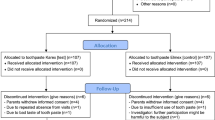Abstract
During the last 50 years, an increasing number of toothpastes have been marketed that include pyrophosphates as anti-tartar (calculus) agents. Pyrophosphates are chelating agents with low toxicity and a broad range of applications, such as food additives and in industrial applications. Like other chelating agents, the prime function is to combine with metal elements and, in toothpastes, to inhibit calcium phosphate deposits in the form of dental calculus. It is well established that pyrophosphates inhibit crystal growth of hydroxyapatite in bones and teeth, and theoretically may negatively affect the demineralisation-remineralisation equilibrium at the tooth surface. Surprisingly, little clinical research has been carried out to assess if the caries protection provided by fluoride toothpaste is compromised by the inclusion of pyrophosphates and the existing evidence is inconsistent. In the absence of more clinical research, it is suggested that children should not use pyrophosphate-containing toothpastes under 12 years of age.
Key points
-
An explanation of the role of pyrophosphates as anti-calculus agents in toothpaste formulations.
-
How pyrophosphates affect the formation of hydroxyapatite in dental tissues and their action as a mineralisation inhibitor.
-
A brief review of the experimental evidence for their efficacy in fluoride toothpastes.
This is a preview of subscription content, access via your institution
Access options
Subscribe to this journal
Receive 24 print issues and online access
$259.00 per year
only $10.79 per issue
Buy this article
- Purchase on Springer Link
- Instant access to full article PDF
Prices may be subject to local taxes which are calculated during checkout
Similar content being viewed by others
References
Specialist Pharmacy Service. What are the excipients in toothpastes? 2019. Available at https://www.sps.nhs.uk/wp-content/uploads/2019/12/UKMI_QA_-Excipients-in-toothpastes-update_June-2019.pdf (accessed October 2020).
Bibby B G. A test of the effect of fluoride-containing dentifrices on dental caries. J Dent Res 1945; 24: 297-303.
Fleisch H, Bisaz S The inhibitory role of pyrophosphate in calcification. J Physiol (Paris) 1962; 54: 340-341.
Meyer J L. Can biological calcification occur in the presence of pyrophosphate? Archs Biochem Biophys 1984; 231: 1-8.
Johansson M S-A, Nancollas G H. The role of brushite and octacalcium phosphate in apatite formation. Crit Rev Oral Biol Med 1992; 3(1-2): 61-82.
Moreno E C, Aoba T, Margolis H C. Pyrophosphate adsorption onto hydroxyapatite and its inhibition of crystal growth. Compend Suppl 1987; 8: S256-S258, S260, S262-S266.
Orriss I R, Arnett T R, Russell R G. Pyrophosphate: a key inhibitor of mineralisation. Curr Opin Pharmacol 2016; 28: 57-68.
Levine R S. The aetiology of dental caries - an outline of current thought. Int Dent J 1977; 27: 341-348.
Levine R S. The action of fluoride in caries prevention. Br Dent J 1976; 140: 9-14.
Mellberg J R. Fluoride dentifrices: current status and prospects. Int Dent J 1991; 41: 9-16.
Featherstone J D, Shariati M, Brugler S, Fu J, White D J. Effect of an anticalculus dentifrice on lesion progression under pH cycling conditions in vitro. Caries Res 1988; 22: 337-341.
Hattab F N. Remineralisation of carious lesions and fluoride uptake by enamel exposed to various fluoride dentifrices in vitro. Oral Health Prev Dent 2013; 11: 281-290.
Mellberg J R, Petrou I D, Fletcher R, Grote N. Evaluation of the effects of a pyrophosphate-fluoride anticalculus dentifrice on remineralization and fluoride uptake in situ. Caries Res 1991; 25: 65-69.
Sullivan R J, Fletcher R, Bachiman R, Penugonda B, LeGeros R Z. Intra-oral comparison and evaluation of the ability of fluoride dentifrices to promote the remineralization of caries-like lesions in dentin and enamel. J Clin Dent 1995; 6: 135-138.
Tanzer J M, Pellegrino J, Thompson A M, Buch R M. Verification of caries inhibition by a tartar control toothpaste. J Clin Dent 2003; 14: 74-76.
Adams D. Calculus-Inhibition Agents: a Review of Recent Clinical Trials. Adv Dent Res 1995; 9: 410-418.
Ripa L W, Leske G S, Triol C W, Volpe A R. Clinical study of the anticaries efficacy of three fluoride dentifrices containing anticalculus ingredients: three-year (final) results. J Clin Dent 1990; 2: 29-33.
Beiswanger B B, Gish C W, Mallatt M E. A three-year study of the effect of a sodium fluoride-silica abrasive dentifrice on dental caries. Pharmacol Ther Dent 1981; 6(1-2): 9-16.
Zacherl WA. A three-year clinical caries evaluation of the effect of a sodium fluoride-silica abrasive dentifrice. Pharmacol Ther Dent. 1981; 6(1-2): 1-7.
Duckworth RM, Huntington E. Evidence for putting the calculus: caries inverse relationship to work. Community Dent Oral Epidemiol. 2005 Oct; 33: 349-56.
Author information
Authors and Affiliations
Corresponding author
Rights and permissions
About this article
Cite this article
Levine, R. Pyrophosphates in toothpaste: a retrospective and reappraisal. Br Dent J 229, 687–689 (2020). https://doi.org/10.1038/s41415-020-2346-4
Received:
Accepted:
Published:
Issue Date:
DOI: https://doi.org/10.1038/s41415-020-2346-4
This article is cited by
-
Phosphorus removal and recovery: state of the science and challenges
Environmental Science and Pollution Research (2022)



